Sports and Nutrition - Physical Education Revision Notes, Class 12 | Physical Education Class 12(XII) - Notes & Model Test Papers - Humanities/Arts PDF Download
Balanced Diet
A balanced diet is defined as one that contains different types of foods in such quantities and proportions that the need for calories, minerals, vitamins, and other nutrients is adequately met, along with a provision for extra nutrients to withstand periods of leanness.
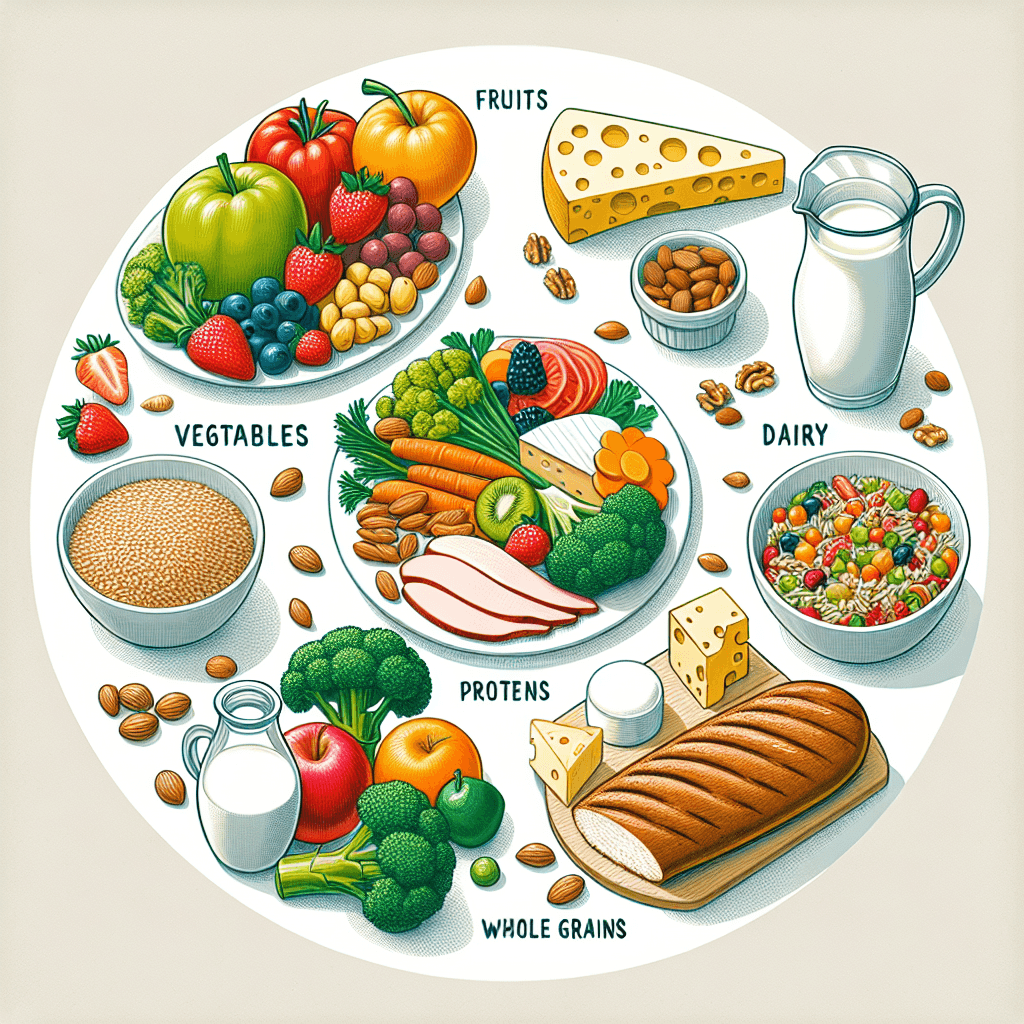
Food Groups in a Balanced Diet
Cereals and Millets:
- Examples: Wheat, rice, jowar, bajra, ragi
- Nutrients: Carbohydrates, proteins, B-vitamins, iron, calcium
Pulses:
- Examples: Red gram, Bengal gram, lentils, green gram
- Nutrients: Proteins, carbohydrates, B-vitamins, iron, fiber, vitamin C (in sprouts)
Milk and Milk Products:
- Examples: Milk, curd, cheese, paneer
- Nutrients: High-quality protein, carbohydrates, fats, calcium, riboflavin
Meat and Meat Products:
- Examples: Meat, fish, chicken, eggs
- Nutrients: High-quality protein, B-vitamins, retinol, calcium (fish)
Nuts and Oil Seeds:
- Examples: Groundnuts, almonds, cashews, sesame seeds
- Nutrients: Fats, proteins, B-vitamins, calcium
Green Leafy Vegetables (GLVs):
- Examples: Mustard leaves, fenugreek leaves, spinach
- Nutrients: Carotene (vitamin A), B-vitamins, iron, fiber, calcium (limited absorption due to oxalates), vitamin C
Root Vegetables:
- Examples: Potato, colocasia, sweet potato, yam
- Nutrients: Carbohydrates, carotene (yellow yam)
Other Vegetables:
- Examples: Brinjal, okra, beans, cauliflower
- Nutrients: Fiber, vitamins, minerals
Fruits:
- Variety: Mangoes, apricots, oranges, papaya, guavas
- Nutrients: Carotene, vitamin C, iron (dried fruits), fiber
Sugar and Jaggery:
- Nutrients: Carbohydrates, iron (jaggery)
Fats and Oils:
- Examples: Ghee, oil, butter
- Nutrients: Fats, vitamin D (fortified oils)
Functional Classification of Food Groups
Energy Giving Foods:
- Carbohydrates and fats
- Examples: Cereals, roots, tubers, sugar, jaggery, fats, and oils
Body Building Foods:
- Proteins
- Examples: Milk and milk products, meat, fish, poultry, pulses, nuts, and oilseeds
Protective or Regulatory Foods:
- Vitamins and minerals
- Examples:
- Fruits: Yellow and orange fruits (mango, papaya), citrus fruits (lemon, orange), others (apple, banana)
- Vegetables: Green leafy vegetables (spinach, mustard), yellow and orange vegetables (carrot, pumpkin), others (beans, okra, cauliflower), root vegetables (potatoes, yam)
Importance of a Balanced Diet
- Ensures adequate supply of essential nutrients.
- Promotes proper absorption and utilization of nutrients.
- Prevents nutrient deficiencies and related health issues.
- Supports overall growth, development, and health.
Nutrition
Nutrients are essential chemical substances in foods required by the body for energy, growth, and maintenance. They are classified into macronutrients and micronutrients based on their daily requirements.
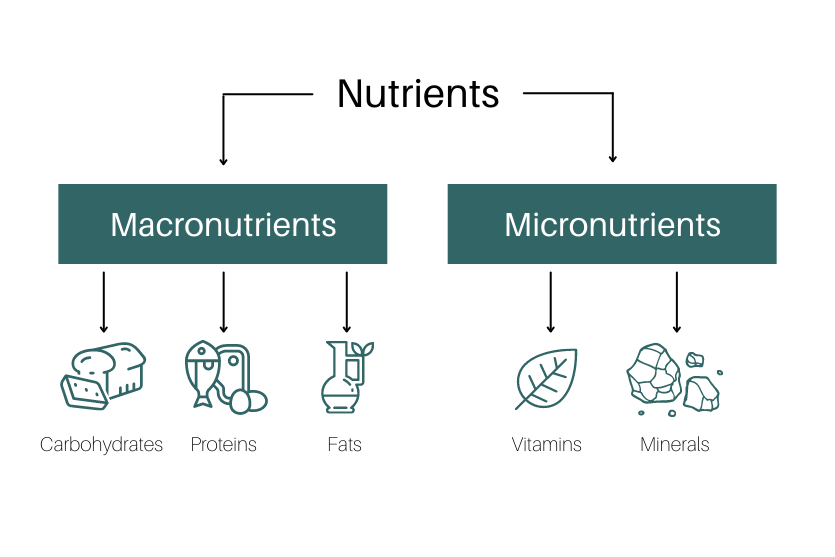 Macronutrients:
Macronutrients:
- Carbohydrates: Primary source of energy.
- Proteins: Build and repair body tissues.
- Fats: Provide energy and help in the absorption of fat-soluble vitamins.
- Water: Vital for metabolic processes and regulatory functions.
Micronutrients:
- Vitamins: Necessary for various biochemical functions.
- Minerals: Involved in numerous body processes, including bone formation, enzyme functions, and maintaining fluid balance.
Carbohydrates
Carbohydrates are organic compounds made up of carbon, hydrogen, and oxygen, providing 4 kcal per gram. They are a major source of energy and are classified into three types:
Monosaccharides:
- Simple sugars like glucose, fructose, and galactose.
- Found in fruits and honey.
Disaccharides:
- Formed by two monosaccharides.
- Examples include maltose (glucose + glucose), lactose (glucose + galactose), and sucrose (glucose + fructose).
- Found in milk, fruits, and sweets.
Polysaccharides:
- Complex sugars formed by multiple monosaccharides.
- Examples include starches and fibers (cellulose).
- Found in whole grain cereals, rice, oats, potatoes, bread, legumes, and corn.
Functions of Carbohydrates
- Provide energy for bodily functions (1 gram provides 4 kcal).
- Main source of energy for the nervous system, brain, and red blood cells.
- Spare proteins for their important functions.
- Enable proper utilization of fats by providing substrates for fat metabolism.
Sources of Carbohydrates
- Simple Carbohydrates: Fruits, milk, and sweets.
- Complex Carbohydrates: Whole grain cereals, rice, oats, potatoes, bread, legumes, and corn.
- Fiber: Whole grain cereals (whole wheat atta), whole pulses, green leafy vegetables, peas, carrot, beans, fruits like guava, apple, orange, and pineapple.
Importance of Carbohydrates in the Diet
- Essential for preventing ketosis by ensuring at least 50-100 grams of carbohydrates per day.
- Inadequate supply causes the breakdown of body fat reserves for energy, leading to the production of ketone bodies and potentially causing ketosis.
Proteins
- Proteins are organic compounds containing nitrogen, carbon, oxygen, and hydrogen.
- Protein molecules are composed of nitrogen-containing amino acids linked in chains.
- Amino acids are the building blocks of proteins, essential for forming various proteins in the body.

Functions of Proteins
- Build and repair body cells.
- Form part of enzymes, hormones, and antibodies.
- Provide energy (4 Kcal/g).
Amino Acids
- There are 20 amino acids, nine of which are essential (EAA) as they cannot be synthesized by the body and must be obtained from the diet.
- The remaining amino acids are non-essential and can be synthesized by the body.
Types of Protein Foods
Complete Protein Foods- Contain all essential amino acids in adequate amounts.
- Examples: Animal sources like eggs, milk, meat, and plant source soybean.
Partially Complete Protein Foods
- Lacking in one essential amino acid.
- Examples: Cereals (lack lysine) and pulses (lack methionine). Combining cereals and pulses in meals can improve protein quality.
Incomplete Protein Foods
- Lacking in more than one essential amino acid.
- Example: Maize protein.
Protein Requirements
- For Indian adults: 0.83 g/kg body weight.
- Example: A man weighing 60 kg needs 54 g/day; a woman weighing 55 kg needs 46 g/day.
- Should constitute 10-15% of total energy intake, not exceeding 35%.
- Requirements increase during sports and exercise, potentially up to 2 g/kg body weight depending on the type of sports and training intensity.
Sources of Proteins
- Milk and milk products, fish, eggs, poultry, meat, legumes, and grains.
Fats (Lipids)
Types of Fats
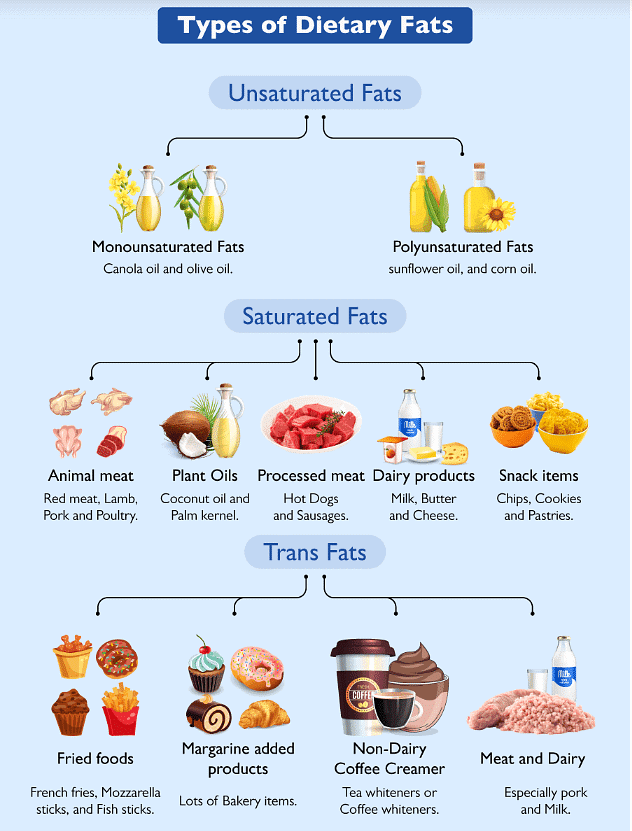
Saturated Fats:
- Solid at room temperature.
- Found in animal products like desi ghee, butter, cheese, cream, red meats, and full-fat dairy products.
- Associated with increased risk of heart disease by raising total and LDL cholesterol.
- Recommended intake should be less than 7% of total calories.
Unsaturated Fats:
- Liquid at room temperature.
- Include monounsaturated and polyunsaturated fats.
- Help reduce blood cholesterol levels.
- Sources: canola, olive, peanut, palmolein, rice bran, sesame oils, nuts like walnuts.
Trans Fats:
- Produced through hydrogenation.
- Found in cookies, biscuits, pastries, and fried foods.
- Increase LDL ("bad") cholesterol and may lower HDL ("good") cholesterol.
Functions of Fats
- Provide energy (9 kcal/g).
- Transport fat-soluble vitamins.
- Part of cell membranes and nerve sheaths.
- Involved in hormone and bile production.
- Excess dietary fat can lead to health problems like heart disease and obesity.
Sources of Fats
- Visible: ghee, butter, cooking oil.
- Invisible: nuts, cereals, pulses, milk, eggs, meat.
Water
Importance of Water
- Essential for life, making up about 60% of total body weight.
- Medium for all body fluids (blood, saliva, digestive juices, urine, sweat).
- Regulates body temperature.
- Acts as a solvent and lubricant for body tissues and joints.
Sources of Water
- Direct ingestion (water, beverages like tea, coffee, fruit juices).
- Foods like fruits, vegetables, milk, cereals, pulses.
Vitamins
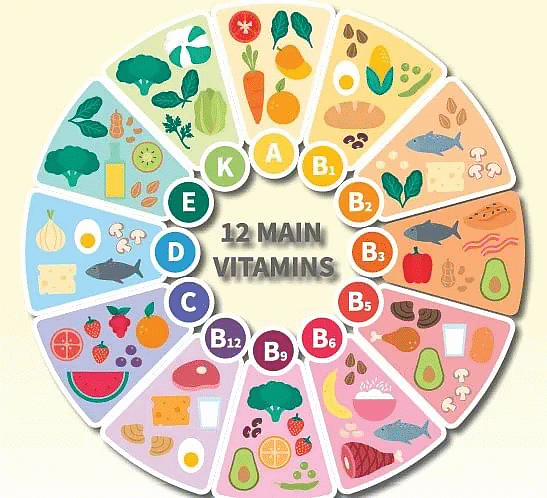
Water-Soluble Vitamins
- Include B vitamins and vitamin C.
- Excess amounts are excreted via kidneys.
- Needed in frequent, small doses.

Fat-Soluble Vitamins
- Include vitamins A, D, E, and K.
- Stored in body cells, not easily excreted.
- Can reach toxic levels if consumed in excess.
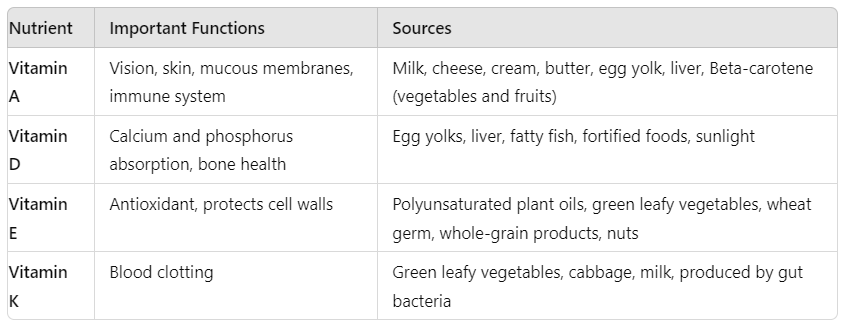
Minerals

Minerals are inorganic elements essential for various physiological functions. They are classified into macro-minerals and micro-minerals.
Macro-minerals
Macronutrients are nutrients required by the body in large amounts to provide energy and support essential physiological functions. They are the main components of our diet.
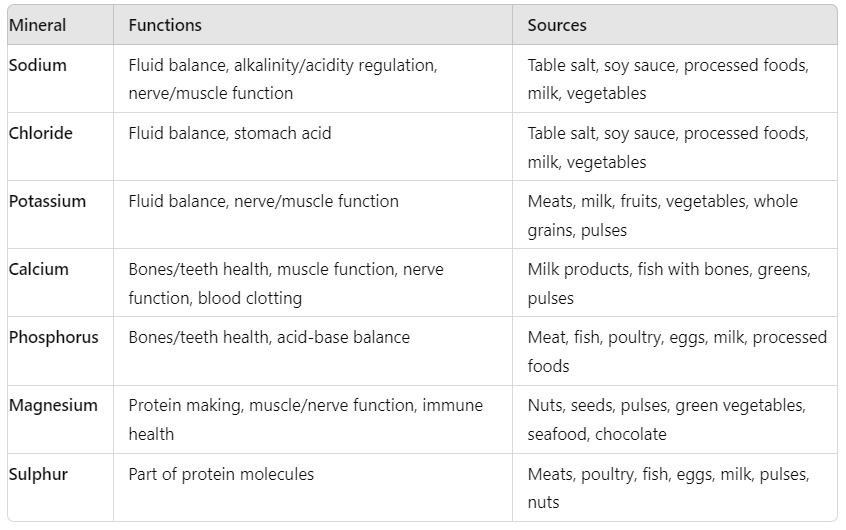
Micro-minerals
Micronutrients are nutrients required by the body in smaller amounts but are crucial for proper functioning of all physiological processes, including immune function, growth, and development.
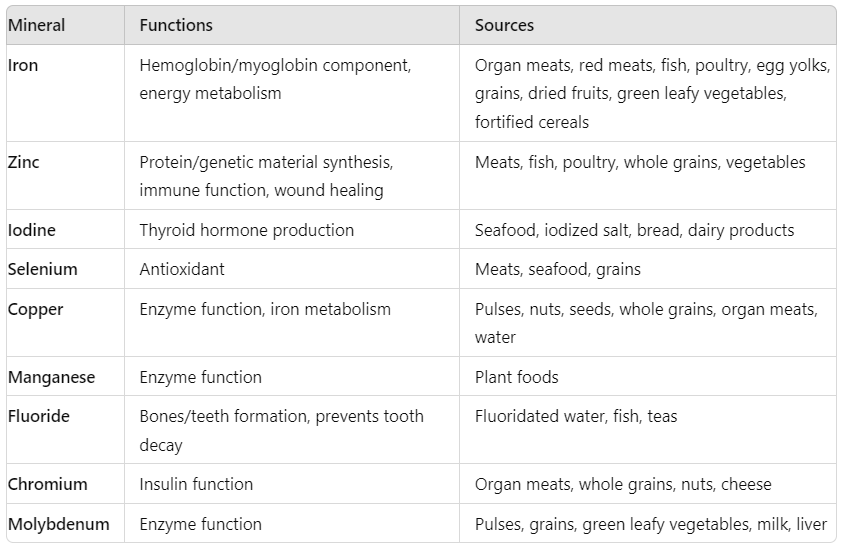
Nutritive and Non-Nutritive Components of Diet
Nutritive Components of Diet
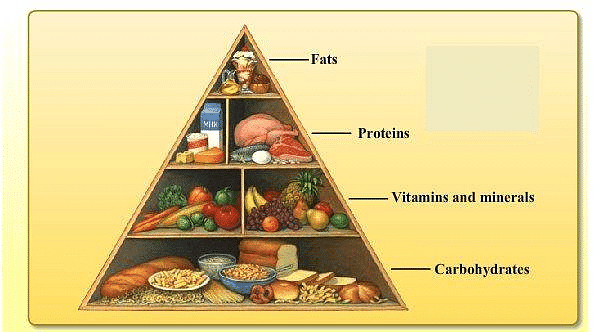
Carbohydrates:
- Function: Main source of energy.
- Sources: Fruits, vegetables, grains, legumes.
Fats:
- Function: Energy storage, insulation, cell membrane structure.
- Sources: Oils, butter, nuts, seeds, fatty fish.
Proteins:
- Function: Growth, repair, enzyme and hormone production.
- Sources: Meat, fish, poultry, eggs, dairy, legumes, nuts.
Non-Nutritive Components of Diet
Non-nutritive components have no nutritional function but may have other effects on food quality and health.
- Phytates: Found in unrefined cereals and millets, they bind iron, zinc, calcium, and magnesium, reducing nutrient availability.
- Tannins: Present in legumes, millets, certain spices, and vegetables, they interfere with iron and protein absorption.
- Trypsin Inhibitors: Found in soybeans and white of duck egg, they inhibit protein digestion; heat treatment can inactivate them.
- Oxalates: Present in green leafy vegetables and legumes, they interfere with calcium absorption.
- Goitrogens: Found in cabbage, cauliflower, turnips, soybean, they interfere with iodine uptake, potentially causing thyroid issues.
Beneficial Non-Nutritive Factors
- Phytochemicals: Found in colorful fruits and vegetables, they act as antioxidants and protect against cancer.
- Anthocyanins: Present in grapes, blueberries, cranberries, they have anti-inflammatory and anti-tumor properties.
- Flavonoids/Phytoestrogens: Found in vegetables, fruits, soybeans, chickpeas, they may reduce the risk of osteoporosis, heart disease, breast cancer, and alleviate menopause symptoms.
- Preservatives: Inhibit microbial growth, prolonging shelf life.
- Spices: Used for flavoring, coloring, and preserving food, some have medicinal properties.
- Coffee: Contains caffeine, stimulates and is one of the most popular beverages globally.
Healthy Weight
Maintaining a body weight that is appropriate for one's height and body composition is known as Healthy Weight
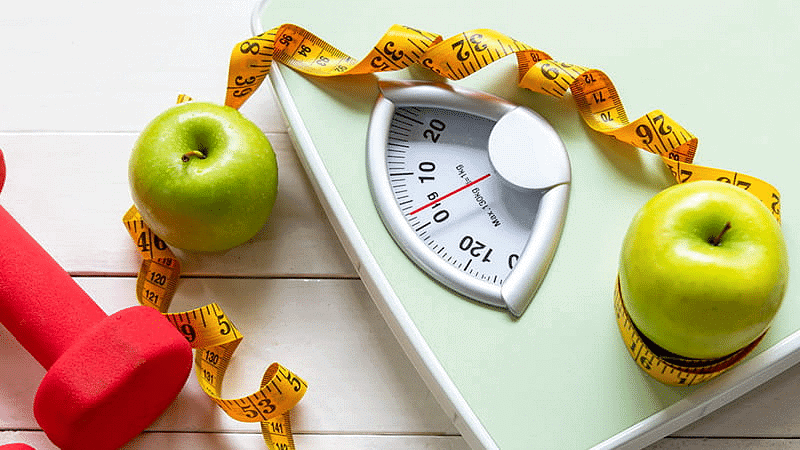
Benefits of Maintaining Healthy Weight
- Reduces the risk of developing conditions like Type 2 diabetes, heart disease, stroke, and obesity-related cancers.
- Enhances overall health and increases the chances of living a long and healthy life.
- Losing even 5-10% of body weight can significantly improve health.
Body Mass Index (BMI)
BMI Categories:
- < 18.5: Underweight
- 18.5-24.9: Normal weight
- 25.0-29.9: Overweight
- 30.0-34.9: Grade I obesity
- 35.0-39.9: Grade II obesity
- ≥ 40.0: Grade III obesity
Waist-to-Hip Ratio (WHR):
- Used to define central obesity.
102 cm (>40 inches) in men and >88 cm (>35 inches) in women indicates central obesity.
Body Fat Percentage: It is assessed using methods like skinfold measurements, bioelectrical impedance, and dual X-ray absorptiometry (DEXA).
Eating for Weight Control
Energy Balance: The balance between calorie intake and calories used is crucial for weight maintenance.- Consuming more calories than burned leads to weight gain.
- Consuming fewer calories than burned leads to weight loss.
Smart Choices:
- Choose foods lower in fat and calories.
- Increase physical activity.
Strategies for Weight Loss:
- Slow and Steady: Aim to lose 0.5-1 kg per week for healthy weight loss.
- Caloric Restriction: Essential for weight reduction, should be accompanied by exercise.
- Diet Modifications:
- Include all food groups: milk and milk products, meat, cereals, pulses, fruits, and vegetables.
- High-fiber foods: Fruits, vegetables, beans, and whole grains.
- Nuts in moderation.
- Switch to low-fat or fat-free dairy products.
- Bake or grill foods instead of frying.
Exercise
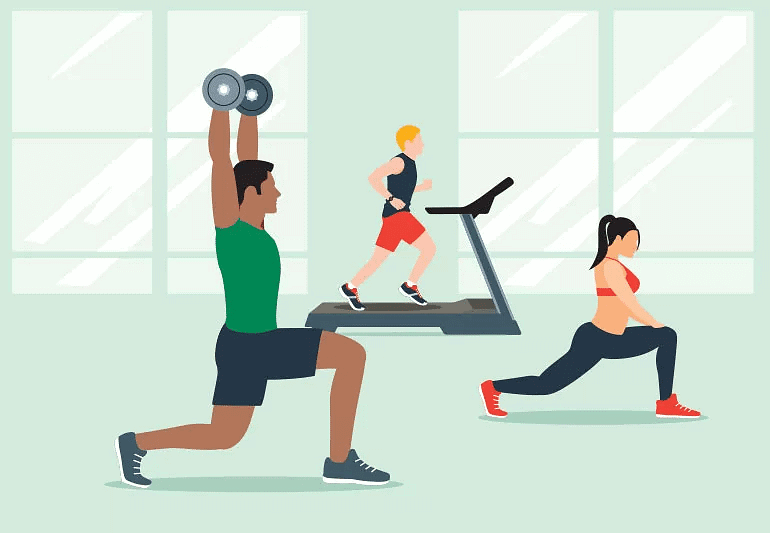
Importance of Exercise
- Increases daily energy expenditure.
- Preserves lean body mass.
- Prevents a decrease in basal metabolic rate.
Additional Tips
- Cook meals at home to control portion size and ingredients.
- Avoid high-salt foods and high-calorie snacks.
- Replace soft drinks with healthier options like water or homemade beverages.
- Drink water to avoid confusing thirst with hunger.
- Eat small, frequent meals to stimulate metabolism.
The Pitfalls of Dieting
- Calorie Deficit: Maintaining a calorie deficit can lead to weight loss. Without exercise, this must be achieved through lower calorie intake.
- Sustainability: Very low-calorie diets are difficult to sustain long-term, leading many to revert to old habits, causing weight regain.
- Body's Reaction: A drastic reduction in calorie intake can slow down the metabolism, putting the body into starvation mode. This reduces the body’s energy requirements and halts weight loss.
- Nutrient Deficiency: Severely restricted diets can lead to nutrient deficiencies. Once normal eating resumes, weight is regained until metabolism normalizes.
- Fad Diets: Diets that cut out entire food groups (e.g., carbohydrates, fats) or rely on ready-made meals are impractical and unhealthy long-term. Moderation is key.
- Anorexia Nervosa: An eating disorder characterized by extremely low body weight, intense fear of gaining weight, and a distorted body image. People with anorexia may severely restrict food intake and misuse laxatives or diuretics.
Food Intolerance
- Definition: Food intolerance is a non-IgE mediated hypersensitivity or non-allergic reaction, characterized by difficulty in digesting certain foods. It differs from food allergies which trigger the immune system.

- Symptoms: Symptoms of food intolerance are varied and can include stomach-ache, bloating, nausea, irritable bowel, hives, migraines, mild fever, and cough.
- Common Causes:
- Absence of an Enzyme: Lack of specific enzymes needed for digestion, e.g., lactose intolerance due to insufficient lactase enzyme.
- Chemical Causes: Sensitivity to chemicals in foods and drinks, such as amines in cheese or caffeine in coffee.
- Toxins: Naturally occurring toxins in foods causing digestive issues, e.g., aflatoxins in peanuts.
- Gluten Intolerance: Digestive issues caused by gluten found in wheat, barley, and rye. It’s different from Celiac disease but can have similar symptoms.
- Food Additives: Intolerance to additives used for enhancing flavors or preserving food, such as nitrates in processed meats or MSG in flavor enhancers.
Food Myths
- Carbohydrates: The myth that fewer carbohydrates are healthier. Choosing healthy carbohydrates, especially whole grains, is important for health.
- Oils vs. Butter: The myth that oils or margarine have fewer calories than ghee/butter. Both have similar caloric content, and some margarines contain unhealthy trans-fats.
- Iron in Apples and Brinjals: The myth that these foods are rich in iron because they turn brown when cut. This color change is an enzymatic reaction, not related to iron content.
- Milk and Fish: The myth that milk should be avoided after eating fish to prevent skin diseases like leukoderma. There is no scientific basis for this belief.
- Drinking Water with Meals: The myth that drinking water during meals affects digestion. Drinking water can help reduce food intake by filling the stomach.
Importance Of Diet In Sports And Pre, During And Post Requirement
Nutrition for Repair and Recovery:
- Sports persons have greater nutritional demands.
- Proper diet aids recovery and performance.
Body Composition Requirements:
- Different sports have different body composition needs.
- Diet can help achieve these goals alongside training.
Nutritional Composition for Performance:
- Pre-competition, during competition, and post-competition meals impact performance, delay fatigue, and speed up recovery.
Nutrition Knowledge:
- Essential for successful fitness, weight loss, and weight gain programs.
- Helps athletes in weight categories achieve body weight goals.
Ergogenic Aids:
- Certain nutrients enhance performance through physiological and psychological effects.
Hydration:
- Dehydration impairs performance.
- Sufficient intake of fluids and electrolytes is crucial.
Physiological Adaptations:
- Adequate diet enhances adaptations during training.
Importance of Diet in Sports

Repair and Recovery:
- Proper nutrition is essential for recovery post-training.
- Sports persons have higher nutritional demands.
Body Composition:
- Different sports require specific body compositions.
- Diet and training help achieve these goals.
Performance Enhancement:
- Pre-competition: Right nutrition improves performance.
- During competition: Delays fatigue.
- Post-competition: Speeds up recovery.
Nutrition Knowledge:
- Essential for fitness, weight loss, and weight gain programs.
- Helps athletes in weight categories achieve goals.
- Off-season diet prevents excessive weight gain.
Ergogenic Aids:
- Certain nutrients enhance performance.
- Provide psychological and physiological benefits.
Hydration:
- Prevents dehydration, which impairs performance.
- Ensure fluid and electrolyte intake before, during, and after exercise.
Training Adaptations:
- Adequate diet enhances physiological adaptations during training.
Carbohydrates in Sports and Exercise
Energy Source:
- Major source of energy for activities.
Caloric Intake:
- Strength sports: 55% of total calories from carbohydrates.
- Endurance sports: 60-70% of calories from carbohydrates.
Type and Timing of Carbohydrate Intake:
- Pre-Exercise: Complex carbohydrates; avoid simple sugars <1 hour before exercise to prevent hypoglycaemia.
- During Exercise: Simple carbohydrate foods for energy replacement.
- Post-Exercise: Simple carbohydrates are best for replenishing energy.
Pre-Exercise Meals:
- Consume 4 to 6 hours before exercise.
- A light carbohydrate and protein snack 30 to 60 minutes before exercise increases carbohydrate availability and decreases protein breakdown.
Proteins for Exercise and Training
Protein Needs: During exercise, muscle bulk increases and tissues break down. Protein is oxidized for energy during prolonged exercises.
Recommendations:
- ICMR (1985): 12-14% of total caloric intake.
- Range: 1g/kg body weight (endurance sports) to 2g/kg body weight (strength sports).
Sources:
- High Quality Proteins: Milk, milk products, meat, and meat products.
- Low Fat Proteins: Skim milk, egg white, fish, chicken.
- Cereal-Pulse Combination: Improves protein quality.
- Supplementation: Generally unnecessary if diet is balanced and energy intake is adequate.
Risks of Excess Protein:
- Renal Degeneration: Increased urea production and water loss.
- Bone Porosity: Increased urinary calcium loss.
Fat Intake in Sports and Training
Energy Density: Fats contribute to energy density and offer protective roles.
Recommended Intake: 25-30% of total calories.
Types of Fats
- Healthy Fats: Polyunsaturated fatty acids (PUFA) from vegetable oils, nuts, seeds; Monounsaturated fatty acids (MUFA) from ground nut oil, fish oil.
- Saturated Fats: Animal fats (e.g., desi ghee, butter) should be limited.
- Invisible Fat Sources: Egg whites, fish, skimmed milk are preferable to high-fat animal foods.
Vitamins and Minerals
- General Functions: Vital for athletes and non-athletes. High energy needs and free radical production in athletes require more vitamins and minerals.
- Sources: Wide variety of nutrient-dense foods, especially fruits and vegetables.
- Supplements: Should not replace food, required amounts can be obtained through diet.
Pre-Exercise or Pre-Event Meal

Pre-Exercise:
- Last dinner should ensure proper sleep and adequate fueling.
- Avoid new or heavy foods.
- Take sufficient liquids or a small snack an hour before exercise.
During Exercise:
- Maintain water balance and control body temperature.
- Replace lost fluids through sweating.
- For activities longer than 60 minutes, consume carbohydrate-electrolyte beverages.
Post-Training/Competition:
- Replace fluids lost during exercise.
- Refill carbohydrate stores (muscle and liver glycogen).
- Replace electrolytes (sodium, potassium, chloride).
During Exercise
Goals During Exercise
- Maintain water balance.
- Control body temperature.
- Sustain normal blood sugar levels.
- Delay fatigue.
Hydration:
- Replace water lost through sweating to avoid dehydration.
- Drink 150-250 ml of water every 15 minutes.
- Avoid carbonated beverages, fizzy drinks, and caffeine.
Carbohydrate Intake:
- For short breaks, consume carbohydrate-rich foods like bananas, juices, and carbohydrate-based drinks (less than 2% concentration) or water.
- For exercise sessions longer than 60 minutes, consume carbohydrate-electrolyte beverages (5-8% carbohydrates).
- For endurance events lasting more than two hours, consume carbohydrate-rich solids or liquid meals to sustain energy levels.
Post-Training/Competition
Goals Post-Training/Competition
- Replace fluids lost during exercise.
- Refill carbohydrate stores (muscle and liver glycogen).
- Replace electrolytes (sodium, potassium, chloride).
Hydration
- Rehydrate to restore fluid balance, continuing hydration after exercise.
- Drink more fluid than lost to compensate for urine elimination.
- Ensure adequate rehydration before the next training session.
- Fluids should be consumed until the body returns to its pre-exercise weight or urine is clear or pale.
Carbohydrate Intake
- Consume high-carbohydrate foods immediately after intense or prolonged exercise to replenish glycogen stores.
- Recommended foods include juice, fruit, sweet curd, or cereal.
- Eat a balanced meal with carbohydrates and good quality protein within two hours post-exercise.
|
12 videos|72 docs|31 tests
|
FAQs on Sports and Nutrition - Physical Education Revision Notes, Class 12 - Physical Education Class 12(XII) - Notes & Model Test Papers - Humanities/Arts
| 1. Why is it important to maintain a balanced diet? |  |
| 2. What are the main components of a balanced diet? |  |
| 3. How can sports and nutrition be connected? |  |
| 4. What role do vitamins and minerals play in a balanced diet? |  |
| 5. How can one maintain a healthy weight through diet and exercise? |  |






















